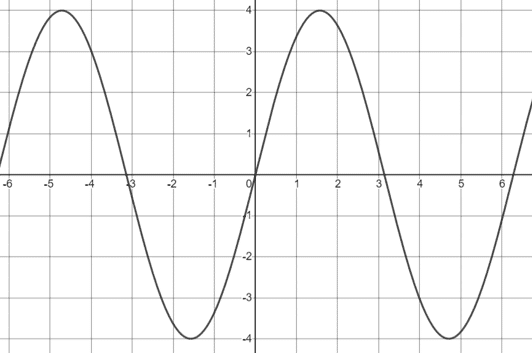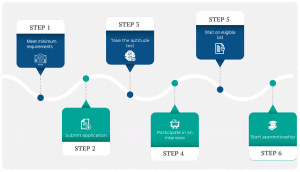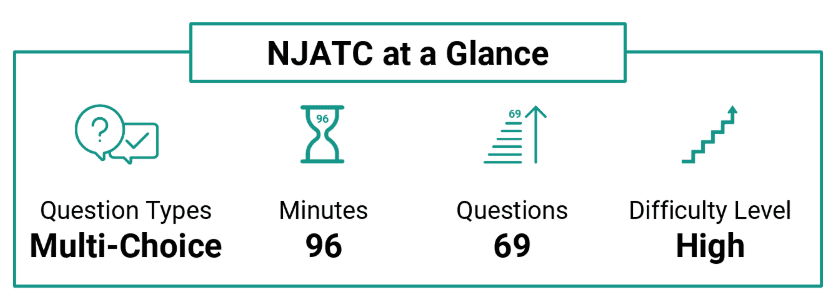Test Breakdown & Sample Questions
The Electrical Training Alliance aptitude test consists of two test sections:
- Algebra and functions
- Reading comprehension
Below you will find a description of each of the tests and the types of questions included in them. You may expand the subsections to find a more in-depth description of the most common types of questions, a winning tip to solve them, and a solved sample question. You will find one more free electrician apprentice practice test in the free tab and three full-length IBEW practice tests in the preparation course, along with dozens of electrician math practice tests.
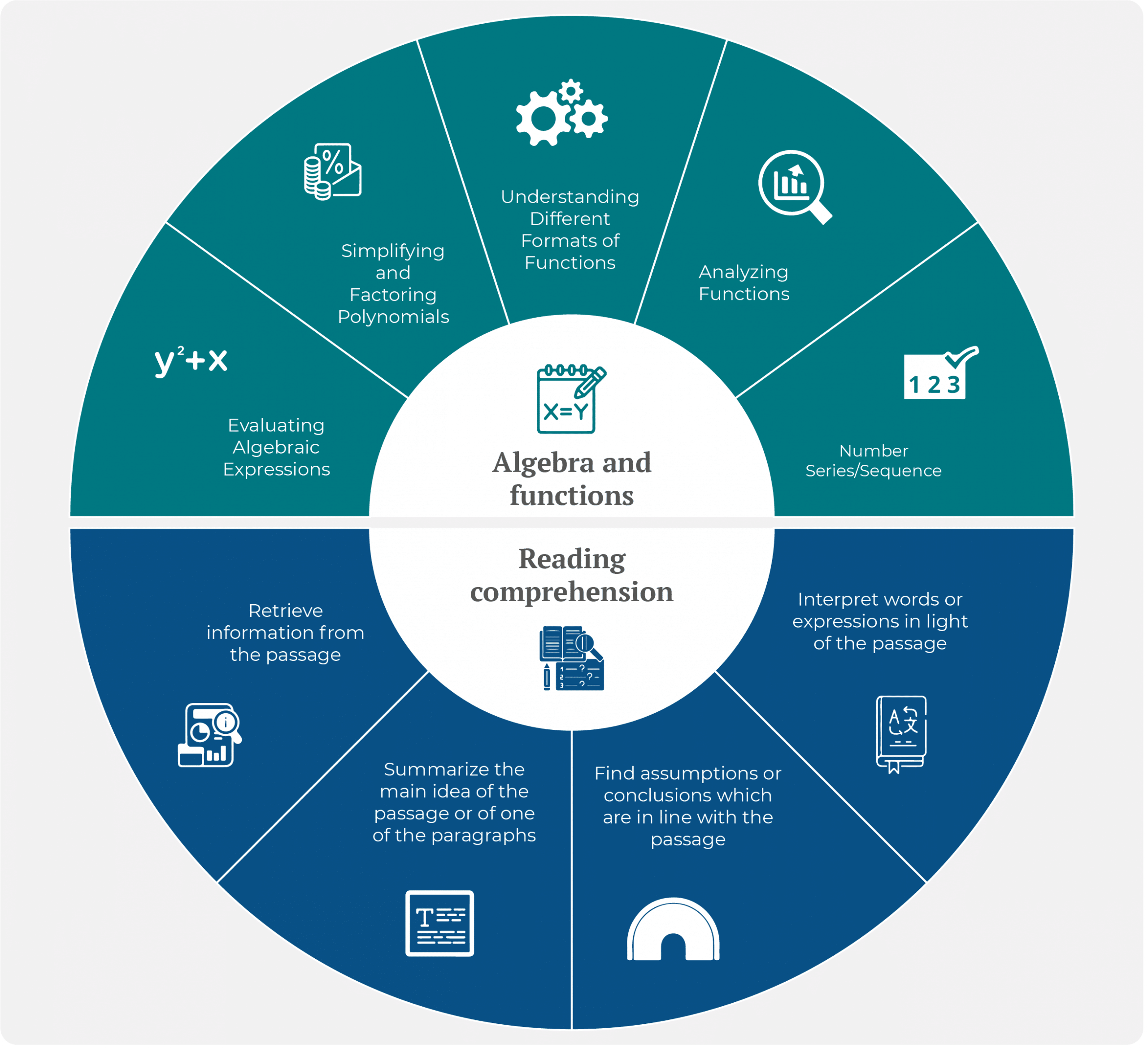
#1 Algebra and Functions Test
This is a test of your ability to solve problems using algebra and associated mathematical functions. It assesses your ability to reason using numbers and numerical concepts. In order to solve the questions on this test, you need to know basic math. This includes a full command of the basic operations, powers, and roots, and how to approach and solve problems that may involve fractions and decimals.
In addition, you should be familiar with elementary algebra and have a basic command of writing, interpreting, and solving algebraic expressions such as linear and quadratic equations.
The most common questions that comprise this section are:
Evaluating Algebraic Expressions
Question Format/Instructions
In these questions, you will need to do one of the following:
- Simplifying expressions while applying the order of operations principles
- Solving and interpreting linear equations—either a single equation or a system of two equations
Winning Tip for Algebra Questions
Oftentimes you will be given an expression consisting of multiple variables; however, you will also be given the values of all the variables but one. To save time, it is usually recommended to begin by placing the values of the known variables. This step significantly simplifies the expression and makes it much easier to continue the solution according to the order of operations.
Try It Yourself – Algebra Sample Question:
Consider the following formula:
(B + C)/2 = 2A – B
If A = 3 and B = 1, what is the value of C?
- 9
- 4
- 2
- 20
The correct answer is 9.
In order to solve this problem correctly, you need to remember the order of operations:
- Parentheses
- Multiplication/Division
- Addition/Subtraction
In addition, while it is tempting to remove the parentheses, in this case, since the values of two of three variables are given, it is better to place the values first, and only then to check whether there are any parentheses left to remove.
In order to find the solution, you need to isolate C.
First step – place the values of A and B:
| (B + C)/2 = 2A – B | Remember A = 3; B = 1 |
| (1 + C)/2 = 2*3 – 1 | Simplify the right side |
| (1 + C)/2 = 6 – 1 = 5 | |
| (1 + C)/2 = 5 |
Second step – isolate C and find the solution:
| (1 + C) | Multiply both sides by 2 in order to remove the parentheses |
| 1 + C = 10 | Subtract 1 from both sides |
| C = 9 |
Simplifying and Factoring Polynomials
Question Format/Instructions
In these questions, you need to demonstrate your proficiency in manipulating polynomials. The two most common formats are:
- Simplifying polynomials – resolving parentheses, performing basic operations, and combining like terms in order to find the simplest way to write a polynomial.
- Factoring polynomials – finding factors that are common to all members of a polynomial or finding two binomials whose product yields a given polynomial.
Winning Tip for Polynomial Questions
Take into account that there must be a correct answer—one of the four answers provided on the test. Therefore, in factoring polynomial questions, if you simply cannot see how to solve the problem, you can always take it the other way around—approach the answers and multiply each of the displayed factors. One of those products must yield the polynomial in the question.
Try It Yourself – Polynomials Sample Question:
Factor the polynomial
2x2 − 2
- (2x + 2)(x − 1)
- (2x− 1)(x + 2)
- 2(x − 1)(x − 1)
- 2(x − 2)(x + 1)
The correct answer is (2x + 2)(x − 1).
The polynomial is 2x² − 2.
It can also be written as 2(x² − 1). Since this is not one of the options, you have to find a way to factor (x² − 1)
(x² − 1) is an example of a special form of quadratic polynomials, which can be written as (a² − b²). In this case, 1 is also equal to 1².
(a² − b²) can always be factored as follows:
(a² − b²) = (a + b)(a − b)
In our case,
(x² − 1²) = (x + 1)(x − 1).
Remembering that you have already factored 2, we get:
2x² − 2 =
2(x² − 1) =
2(x + 1)(x − 1) = [apply the distributive property on 2(x + 1)]
(2x + 2)(x − 1)
Remember –
As an alternative solution path, you can always use the FOIL method and multiply each of the factors suggested in the answers. One of them ought to yield the correct polynomial.
In this particular case, this could even be a simpler way of finding a solution.
Understanding Different Formats of Functions
Question Format/Instructions
In these questions, you need to demonstrate your command in various forms of functions. Usually, you will need to find which two formats represent the same function. Information may be presented in the form of a function equation, plot-line graph, tables of ordered pairs (x,y), or textual inferences about the function.
Winning Tip for Function Formats Questions
Take into account that the required knowledge for the test includes manipulating second-, third-, and fourth-degree polynomials, but it does not include recognizing plot lines of such polynomials. You are only expected to recognize and interpret graphs of linear (first-degree) functions. Therefore, if the question introduces graphs that are clearly not graphs of linear functions, you do not have to interpret them. They are almost certainly not part of the correct answer.
Try It Yourself – Function Formats Sample Question:
Consider the following table, which contains values that are found on the graph of the function:
| x | y |
|---|---|
| 0 | 4 |
| 1 | 2 |
| 2 | 0 |
| 3 | 4 |
| 4 | 2 |
| 6 | 0 |
Which of the following options provides accurate information in regard to the aforementioned function?
- y = 4x – 2
- The function is defintely not a linear function.
- x = y – x + 2
- This graph represents the values in the table.
The correct answer is B.
The table describes an inconsistent relationship between y and x. Two pieces of information reveal that it is not a linear function. First, while the value of x continuously increases, the value of y alternately increases and decreases. In a linear function, the growth will be continuously positive or negative. Second, two different x-values are paired with different y-values. This never happens with linear functions.
Functions A and C are linear functions. To prove they are not the correct answer, you can place several values of the table in the formula and realize that it is not a perfect fit.
In Graph D there is a non-linear function. As a rule of thumb, the scope of the test does not include such functions; therefore, it is safe to assume that it is not the correct answer.
Analyzing Functions
Question Format/Instructions
These questions are considered the most difficult questions on the test. You are usually given a rather simple algebraic expression and then you are presented with four conclusions regarding that expression. These conclusions are often written in an unintuitive manner, causing you to invest much time deciphering them and solving the problem.
Winning Tip for Analyzing Functions Questions
Always remember that the correct answer must always be correct. An answer may be partially correct; for example, a conclusion that a function will yield positive y values to all x-values greater than 2 may be correct in the range 2 < x < 6 but incorrect for the range x > 6. The detailed explanations in iPrep’s course include methods to overcome this difficulty.
Try It Yourself – Analyzing Functions Sample Question:
Consider the following formula:
3D = E – 3
Which of the following statements is true for this formula?
- If D is less than -1, E is positive.
- If D is greater than -3, E is negative.
- If D is greater than -1, E is positive.
- If D is greater than -3, E is positive.
The correct answer is C.
Here’s a detailed video walk-through of the explanation:
All the answers refer to the value of E as a function of the value of D. To solve the problem systematically, you can plot the graph line and compare it with statements A-D. Since 3D = E – 3 is a linear expression, you only need two points to plot the graph line. The simplest points to find are the interception points with the axes. To find these, you should place in the expression D = 0 and E = 0.
If D = 0, then:
3D = E – 3
3*0 = E – 3
0 = E – 3 \+3
E = 3
And we get the first (D, E) point’s coordinates (0,3).
If E = 0, then:
3D = E – 3
3D = 0 – 3
3D = -3 \÷3
D = -1
And we get the second (D, E) point’s coordinates (-1,0).
The following image depicts the plot line of this linear expression, based on these points:
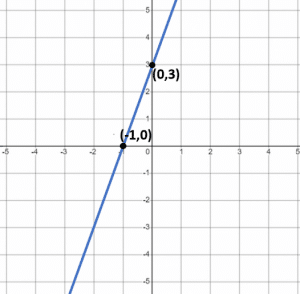
If you compare statements A-D to the graph, you can see that only statement A is completely false, statements B and D are partially true, and only statement C is always true.
Number Series/Sequence
Question Format/Instructions
In these questions, you are presented with a sequence of numbers. Your goal is to determine which of the options is the next number in the series.
Winning Tip for Number Series Questions
Take the time to write the numerical differences between the members of the series and even the numerical differences between the members of the series of differences. This procedure will make it easier for you to identify patterns such as repeated operations between members or a steady alteration in the differences between members of the series.
Try It Yourself – Number Series Sample Question:
What is the next number in the following series of numbers?
16 29 42 55 68
- 93
- 71
- 89
- 81
- 73
The correct answer is 81.
Explanation:
Look at the differences between the numbers:
16 29 42 55 68
+13 +13 +13 +13
This means that every number in the series is equal to the previous number + 13.
It can be formally written as follows: an+1 = an + 13
The next number of the series is equal to 68 + 13 = 81
For learning purposes, the next numbers of the series would be:
81 + 13 = 94
94 + 13 = 107
107 + 13 = 120
#2 Reading Comprehension Test
Question Format/Instructions
This test measures your ability to obtain information from written passages. You will be presented with a passage followed by a number of questions about it. The passages will not necessarily be related to the world of electrical apprenticeships. The questions that follow the passage usually require you to do one or more of the following tasks:
- Retrieve information from the passage
- Summarize the main idea of the passage or of one of the paragraphs
- Find assumptions or conclusions which are in line with the passage
- Interpret words or expressions in light of the passage
Winning Tips for Reading Comprehension Questions:
- Read each passage and question in the order in which they appear on the test. This will help you to maintain your focus and to avoid missing questions.
- Time is of the essence so skip particularly difficult questions and get back to them if time allows it.
- Read all the answers as 2 or 3 answers may be “acceptable” but only one question is the best answer.
Reading Comprehension Sample Question
Here are some nutritional facts about some of the foods you eat.
- It is best not to center every meal around meat. Meat is harder for your body to break down than other foods.
- It is cheaper and better for you to bake your own bread, cookies, and cakes than to buy pre-packaged baked goods. Pre-packaged food often contains preservatives and additives that your body doesn’t need.
- Try to eat less saturated fat as is found in cheese, bacon, and oil. Too much fat isn’t good for your heart.
- There is a lot of sodium existing in foods, so it is not necessary to add any extra salt when you cook. Your body needs very little salt. Too much salt can make your body retain water, which may make you feel bloated.
According to the passage, what results from eating foods to which you add extra salt?
- You will be eating more salt than you need.
- You can become very thirsty.
- Foods will taste too salty.
- Your food will retain the liquid it is cooked in.
The correct answer is A.
The information can be drawn from this section in the passage:
“There is a lot of sodium existing in foods, so it is not necessary to add any extra salt when you cook. Your body needs very little salt.“
Did you know?
The IBEW Aptitude Test (NJATC) has two sections: (1) algebra & functions (2) reading comprehension. A score of 4 is required to get to the pre-apprenticeship practice test interview round. There is no need to memorize formulas or factual material in order to do well on the test, and previous knowledge of electrical work is not required.
IBEW / NJATC Preparation Strategies
1. Master the fundamentals to ace the test
Beginning your studying by taking a full-length IBEW aptitude test might be discouraging. All the questions rely on the fact that you have a basic command of arithmetic, decimals, exponents, etc. If you approach the test without going over them, you might feel rusty and underconfident. On the other hand, if your basic skills are refreshed, the entire test experience will feel better, and you are likely to be more relaxed and confident. Therefore, it’s a good idea to use a preparation course that will both refresh your math and basic reading skills, and offer real test simulations.
2. Utilize more than the NJATC math course
The NJATC math course, which is offered to applicants upon registration, teaches the basics of algebra but does not set a goal to help prepare you for the test. In fact, the questions you will encounter on the actual electrician math test (the algebra and functions sections) are almost nothing like the questions in the course. Therefore, it is recommended to find a course that includes IBEW apprenticeship test questions like those you will find on the real test.
You should learn exactly what is required of you in each type of question and how to approach them. Be advised that the course provided by “Electric Prep,” which used to be recommended by some IBEW locals, covers the same aspects as in the NJATC math course, but they do not provide up-to-date IBEW aptitude test simulations. iPrep’s course provides a review of all the fundamentals and provides test simulations that closely mimic the real pre-apprenticeship test.
3. Choose an online preparation course over a study book
With today’s technology, online courses offer only advantages in comparison to books. Online courses tend to be more up-to-date than books as they can be easily edited in contrast to books that are not often revised or reprinted. Always look for current and genuine customer reviews that are given consistently through time. This is a feature lacking in many books, even those sold online. Unfortunately, some dubious book publishers exploit the fact that customers cannot review their books, and publish books that may be far from what they need.
Lastly, online courses serve as a better test simulation. When you take the aptitude test at your local JATC, you will do it in front of a computer, and it will be timed, as it should be in an online course. This is a feature that books cannot offer.

4. Start practicing for the exam at least two weeks in advance
Our brain has its own way of learning. While you may only need 20 hours to cover all the available IBEW practice tests, having some no-practice time between practice sessions may prove very useful. In these intervals, your brain takes a break to process and internalize the knowledge you have gained. You may be surprised by how much better you understand the materials after taking a break for a couple of hours or even the morning off after covering a challenging lesson.
The same goes for the real test. Do not study hard on the morning of the test or while taking the bus to the JATC. Refresh your mind and you will be sharper while taking the test. That being said, it is still recommended to answer a couple of questions just before taking the test in order to “start your (brain) engine.”
5. Keep in mind that the test is timed
IBEW test takers often report that the test passes like a breeze. The time is there and then it is gone. This factor must be taken into account when you are practicing since while you may get a perfect score without the time limit, it might not be the case with the time constraints. To avoid unnecessary stress due to time limitations, you must adopt some time-saving techniques:
- Sometimes, in the middle of your calculations, you may already be able to mark the correct answer. This usually happens in math questions, in which you can often eliminate wrong answers before reaching the solution. The practice drills will offer you some useful elimination techniques.
- Answering the toughest questions on the test may be fun and challenging but may also be very time-consuming. It is alright to skip questions that confuse you or that you deem too difficult in order to answer more questions overall.
- After you have submitted a practice test, take the time not just to see if you got the question right or wrong but also to ask yourself if you could have used a slightly different method that would have saved you some time.
6. Create a study environment that resembles the real test’s conditions
After refreshing yourself with the fundamentals and becoming more confident in your abilities, practice full-length electrician apprenticeship practice tests in conditions that resemble the real test’s environment. Strictly maintain the time limit. Apply all the test limitations—no textbooks, no mobile phones, no calculators, and only a 10-minute break between test sections. Experiencing all of these in advance will make the actual test less intimidating and will reduce your stress levels.
7. Get your body and soul ready for the test
Try to keep calm. Study in advance, make arrangements for test day, and find the means (such as a quiet zone, music, or workout) to put yourself in the optimal zone in which you are not too nervous but still sharp and focused.
Eat well, hydrate yourself, and sleep well in the days before the test, so your body will not fail you and you will feel vital and energetic on the morning of your aptitude test.
Reduce disturbances before the test. This test is a pivotal step in your application and you don’t want to lose your focus. Try not to have any commitments right before or after the test, and put your mobile phone on flight mode so you don’t get any unsettling messages right before the test.
IBEW / NJATC Test Features
1. Get a job in the industry
Since the test is created by the National Joint Apprenticeship and Training Committee, candidates can rely on it to get training in the electrical construction industry. After all, having the most up-to-date training is a plus if you want to get the job of your choice.
2. Uniform test across all apprenticeships
The IBEW union and NECA organization worked in close coordination and sponsored the NJATC aptitude test creation, which is currently the only applicable pre-employment electrical test. Therefore, no matter which apprenticeship you’re eyeing, you will face the same electrical apprenticeship aptitude test, the one described in this page.
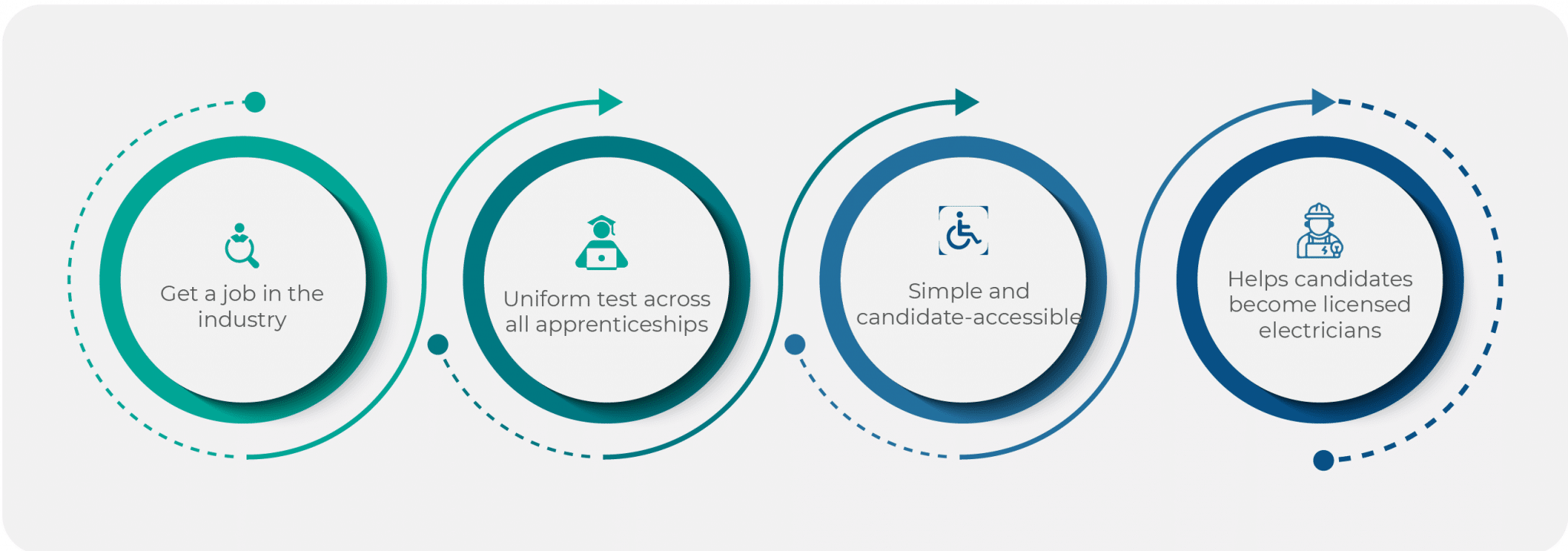
3. Simple and candidate-accessible
Vigorous practice and focus will help you achieve a passing score. To take the test, all you have to do is fill out the test application. Once you have done this, you will be allowed to take the Electrical Training Alliance Aptitude Test. If you receive a minimum score, you will move on to the interview round. Good overall scores in these sections will help you on your way to becoming a skilled electrician.
4. Helps candidates become licensed electricians
Since the Electrical Training Alliance is administering the test, the candidates that do pass will have the option of starting an IBEW/NECA apprenticeship, which eventually leads to getting a license to work as a lineman, electrician, or telecommunication installer technician.
Technical Facts
Fast Facts (tl;dr)
- Two test sections:
- Algebra and Functions – 33 questions in 46 minutes
- Reading comprehension – 36 questions in 51 minutes
- Total administration time may take up to two and a half hours.
- Calculators are not permitted.
- Bring a photo ID.
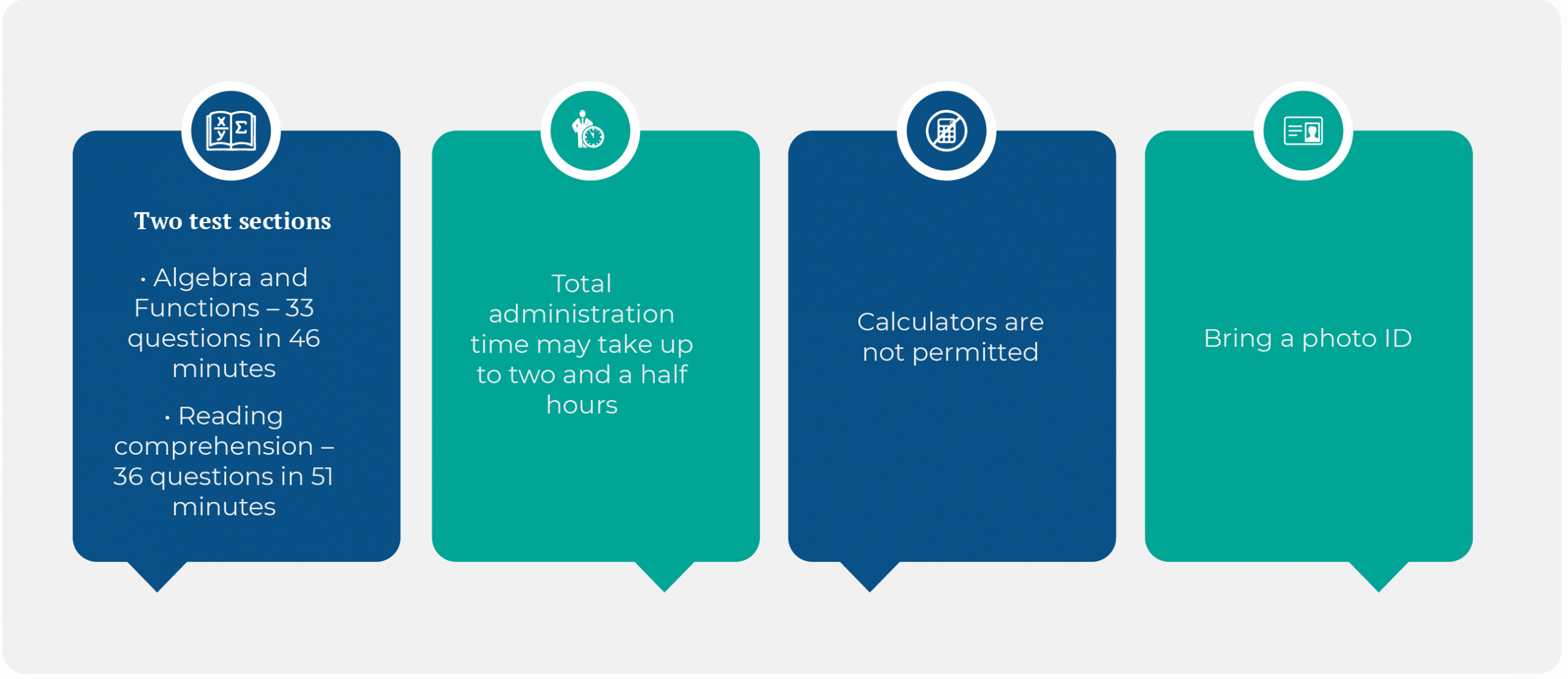
1. Two Sections
You will have to pass two test sections:
I. Algebra & Functions: You have 46 minutes to answer 33 questions. The algebra section features topics including:
- Solving a linear equation of two variables
- Working with expressions like subtraction, multiplication, division, and polynomial factoring
- Quadratic equations like square roots, quadratic formula, graphing, and practical applications
II. Reading Comprehension: You’ll be given 51 minutes to complete 36 questions in this section. You will get several passages to read, each followed by a set of questions beneath it.
Please note:
- You are not allowed to bring in a calculator
- Bring a photo ID to be admitted into the test
2. Timed Test
The electrician math test is 46 minutes long and the reading test is 51 minutes long. While this only amounts to a little over an hour and a half of testing, expect to spend approximately two and a half hours, and possibly up to three hours in the testing center.
3. Taken Online
The test is usually computerized but you cannot take it at home. The local Joint Apprenticeship and Training Committee will administer the test in-person. You will be given an address to the closest local test station to take the exam.
4. Know Your Algebra
It is recommended to have at least a basic command of high-school-level algebra, functions, and equations. There is no need to memorize formulas or factual material in order to do well on the test, and previous knowledge of electrical work is not required. You should also practice your reading comprehension skills.
5. No Negative Score for a Wrong Answer
Your correct answers are the ones that matter and your scores will entirely depend on them.
6. Can be Retaken
You can reapply or retake the test after six months.
7. Common and Past Names of the Test
The electrical pre-apprenticeship aptitude test has changed its name in the past years. In addition, people colloquially refer to it in various names, depending on the context. If you encounter information regarding the test using any of the following names, know that they all refer to the same test:
- Electrical Training Alliance Aptitude Test (current name)
- NJATC Aptitude Test (former name)
- IBEW Aptitude Test / IBEW Apprenticeship Test
- NECA Aptitude Test / NECA Apprenticeship Test
- Pre-Apprenticeship Aptitude Test
- JATC Test
- ETA Aptitude Test
- Electrical Aptitude Test
- Electrician Apprenticeship Test / Electrician apprentice test
- Local X Aptitude Test
- Electrician math test / NJATC math test
- PSEJATC aptitude test
8. Basic Requirements to Apply
- You must be at least 17 years of age at the time of application and 18 at state registration.
- Proof of completion of a year-long algebra course with passing grades
- A high school diploma or GED
- Good health and physical shape
- Usually, a valid state driving license is required
9. Step-2 of a Three-Step Application Process
The NJATC aptitude test, now administered by the Electrical Training Alliance, is the middle step in every aspiring electrician apprentice’s hiring journey. These three steps of the application process are:
- Meet the minimum requirements, which are set independently by each local testing station.
- Take the Electrical Training Alliance Aptitude Test, which is uniform across the nation.
- Have an in-person interview with your prospective employer.
Candidates with a minimum score of 4 are eligible for the next round—the personal interview. Other candidates with at least 4,000 hours of previous electrical construction experience don’t need to meet the minimum score criteria to reach the personal interview stage. Pass these three steps and you will be placed on the eligibility list.
10. Combined Score
The combined scores of your pre-apprenticeship aptitude tests and interview will be used to generate the overall ranking of your performance, which is reflected by your position on the eligibility list.
11. Score Eligible for at Least 2 Years
You are eligible for the apprenticeship program for a minimum of two years. If you are not selected for training in two years, you will need to reapply for the test.
12. Required for all Electrical Apprenticeships
There are four areas of electrical apprenticeship—outside linemen, inside wiremen, telecommunication installer technicians, and residential wiremen. To become an apprentice in each of these areas, you will have to pass the NJATC pre-apprenticeship aptitude test (aka the Electrical Pre-Apprenticeship Test). The aptitude test is identical for each of the apprenticeships.
Results Scale and Interpretations
The IBEW Aptitude test is scored on a Stanine scale of 1-9. Most local unions require a minimum of 4 out of 9 to qualify for an interview, although some will interview a candidate who scores a 3 and others require a 5.
The Stanine score scale, used in the IBEW Apprenticeship test, ranges from 1 to 9. It simplifies test results into nine levels, with 5 as the median score. Lower scores (1-4) indicate below-average performance, while higher scores (6-9) signify above-average performance. Achieving a score of 4 or above is generally necessary for further consideration in the apprenticeship process.
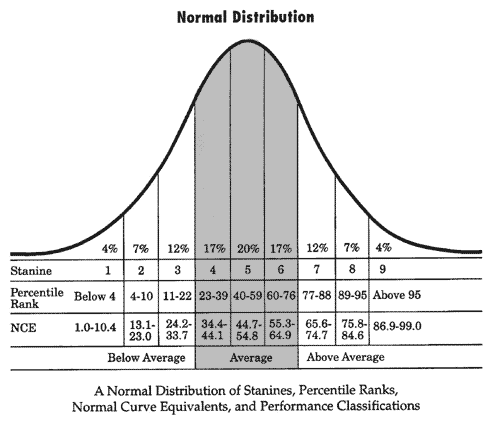
After completing the test, you can expect to receive a pass/fail letter, like the one pictured below. Some locals include your score in the letter, while others choose to keep that information to themselves. If you pass, you will be scheduled for an interview.
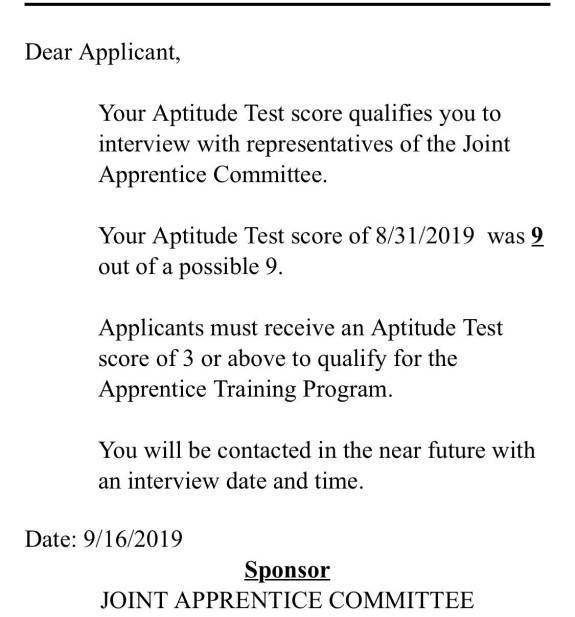
IBEW/NJATC FAQs
The Electrical Aptitude Test is a pre-employment test that measures a candidate’s abilities in reading comprehension and algebra. Hiring companies will look at the results to determine whether you are a good enough candidate to be interviewed.
Getting a high score on the test will help recruiters feel confident that you will be an asset to their company and will catch on quickly in your new role.
The Electrical Aptitude Test is comprised of a total of 69 questions in two different sections:
1. Algebra and functions
2. Reading comprehension
You will be given 46 minutes for the math section and 51 minutes for the verbal section, which means that you have an average of less than 90 seconds to answer each question.
However, there is no need for you to answer all the questions because only the correct answers count. It is important to try to answer as many questions correctly as you can.
About 2-4 weeks after you take the test, the training center will generate your raw score and percentile ranking and send you the results, indicating whether you have passed or not.
The IBEW aptitude test consists of a total of 69 questions in two sections: 33 questions in the algebra and functions section and 36 questions in the reading comprehension section.
Begin with a practice IBEW apprenticeship test, so you can see where your weaknesses are, and then begin studying the material that you found difficult. If you haven’t been in a classroom in a while, find a course to help you brush up on basic algebra and functions. After taking the course, test yourself again in conditions that simulate the actual test and see how well you did.
Yes, all the questions are multiple-choice questions with 4 answers to choose from.
No, calculators are not allowed on the IBEW electrician apprentice math test. You are allowed to use scratch paper for your calculations.
While the algebra knowledge required to pass the test is rather basic, the math section of the NJATC aptitude test is considered difficult and challenging to those who have not practiced algebra since high school or college. The time constraints raises the level of difficulty as test-takers are expected to answer each question in less than a minute and a half.
This section of the IBEW aptitude test is often referred to as the electrician math test. The electrician math test covers two main aspects—algebra and functions. For the algebra part, you must know the order of operations, how to solve linear equations, and how to factor and simplify polynomials. For the functions part, you must be familiar with characteristics of linear functions including how to plot their graphs. You should also be familiar with solving number series problems.
The passing score of the IBEW/NECA aptitude test is 4 out of 9; however, the higher your score is, the greater are the chances that you will have an advantage in later recruitment phases and will be offered a place in the apprenticeship program if the number of openings is limited.
In most cases, to pass the NJATC test, you must score 4 out of 9. Then, if you are a leading candidate, you will be called for further interviews. In some cases, where the number of applicants to the program is significantly high, the passing score may be set to 5 out of 9. Outside lineman apprenticeships for NEAT (Northeastern Joint Apprenticeship Training) only need to get a 3 out of 9 on the aptitude test.
The NECA aptitude test is the unofficial name of the NJATC aptitude test, provided by the Electrical Training Alliance, the organization sponsored by NECA and IBEW to create training programs for electrician apprenticeships.
Yes, the electrical apprentice aptitude test is the same to all four apprenticeship programs—inside wireman, outside lineman, residential wireman, and telecommunications installer technician. The only factor that may vary is the score that is required to be accepted to each of the programs (3, 4, or 5 out of 9 points, depending on the local and the program).
IBEW/NJATC Test Tips
1. Work on Your Skills
Practice! Practicing the different sections repeatedly will help you improve your skills and help you answer more questions correctly during the time limit.
2. Read Fluently
Read plenty of books prior to the test to improve your reading comprehension (not included in the above sample questions, yet included on the test and in iPrep’s course.)
3. Practice Math Equations
You will encounter a variety of math questions, including algebra, fractions, addition, subtraction, multiplication, and division. It is essential to practice and sharpen your math skills.
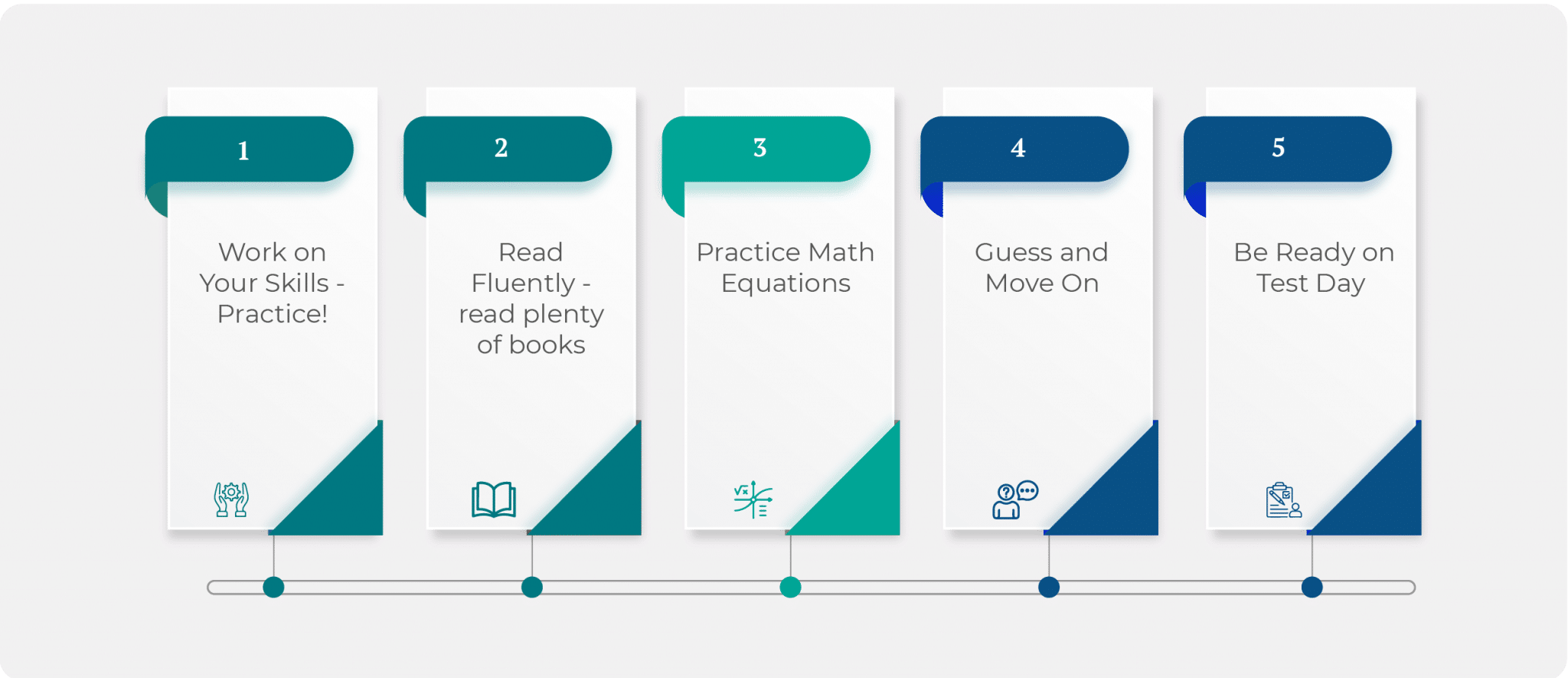
4. Guess and Move On
Since wrong answers will not negatively impact your overall score, and given the time limitation, don’t spend too much time on any one question; simply guess the answer and move on.
5. Be Ready on Test Day
For optimal test performance, get a good night’s rest and eat a nutritious, yet not too heavy meal prior to taking the tests. Report to the test center early and make arrangements to spend at least three hours there. Plan in advance so you have minimal-disturbance testing conditions—go to the bathroom in advance, bring earplugs, and turn off all beeping and vibrating devices.
Administration
- Test Location: The test is held at the local JATC office, the same one to which you applied.
- Test Schedule: Tests are held in every JATC every couple of weeks/months. Available test dates will be sent to you if you meet the minimum requirements for the apprenticeship.
- Test Format: Multiple choice on computer.
- Test Materials: Tests are taken on a computer. Calculators are not allowed, and smart devices will be stored for the duration of the test. Writing instruments are provided but bring your own, just in case.
- Cost: The non-refundable application fee varies between locals but mostly varies between $20-$50.
- Retake Policy: you may take the test battery again after a period of six (6) months has elapsed from your most recent test date. If you try to take the test beforehand, you will have to wait six additional months. To take the test again, you are required to pay the processing fee once more.
Where do I take the Electrical Training Alliance Aptitude Test?
The Test will be administered at your local JATC training center.
What score do I need to pass the test?
To pass the aptitude test, you have to get a score of at least 4 out of 9. However, if you fail to qualify, you can reapply six months after the date of the original test.
How and when will I know if I passed the test?
The score of your test will be sent to your respective training center within 2-4 weeks after the test. The center will then mail you the result and let you know whether you passed or not.
Is there anything else I have to bring on the day of the test?
Yes, a valid photo ID is a must; otherwise, you won’t be allowed to take the test.
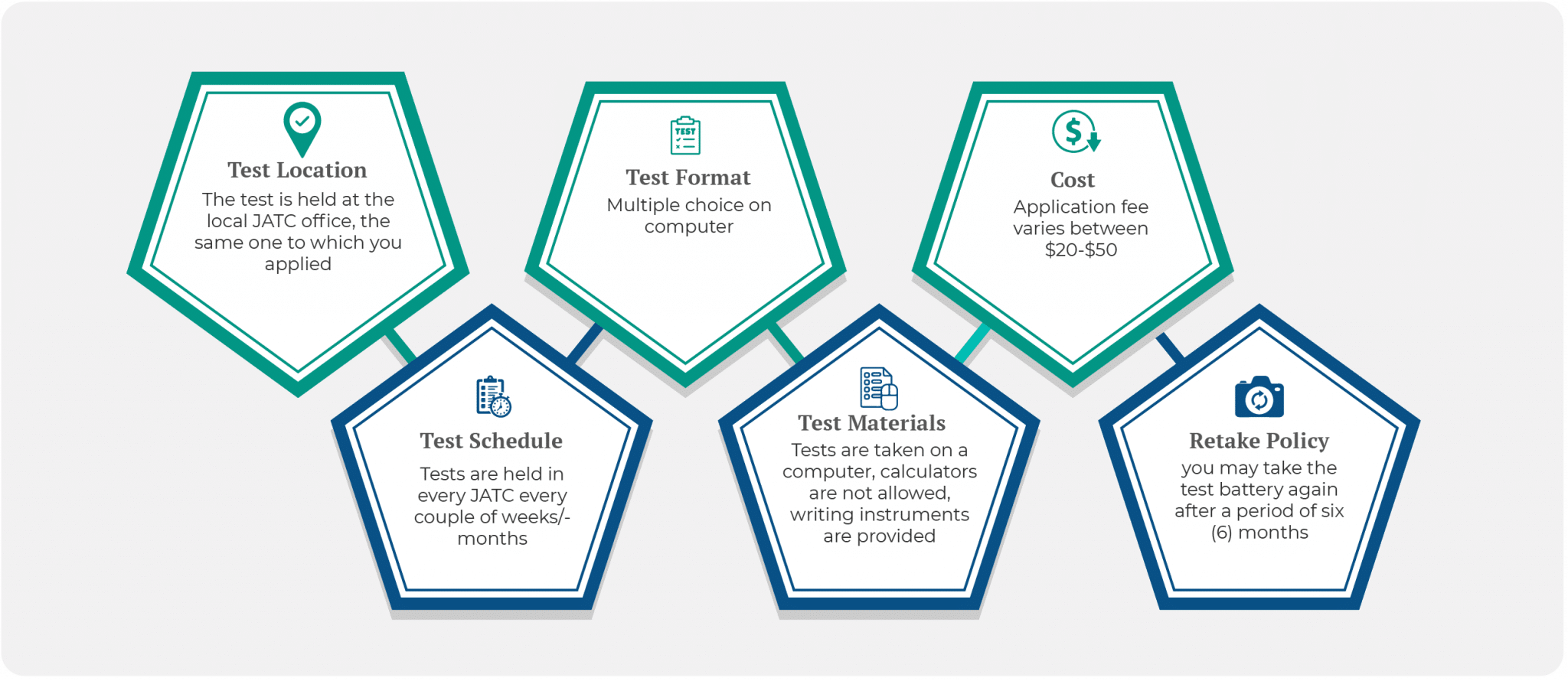
Test Provider
Many JATCs (Joint Apprenticeship and Training Committees) use the Electrical Training Alliance’s Electrical apprenticeship aptitude test to help them recruit electrical apprentice candidates.
The Electrical Training Alliance has a long history of providing educational material for the electrical and technical industry. It is the only electrical training alliance whose programs are certified by IBEW and NECA. With at least one training center in each state, the Electrical Training Alliance (aka NJATC) aims to help candidates with their unique and high-class courses.
If you want to be a licensed electrician or technician, you must take the Electrical Training Alliance Aptitude Test. Having passed this pre-employment electrical test, you will be able to become an electrician apprentice, usually with one of the International Brotherhood of Electrical Workers (IBEW) union locals, or the National Electrical Contractors Association (NECA) apprenticeship programs.
Aptitude Tests by IBEW Locals
While the electrician apprenticeship aptitude test is administered by the local JATC, the IBEW local to which you send your application usually determines whether you will take the aptitude test or not. Each local plans and advertises a yearly recruitment plan, comprising electrical apprenticeship openings. The locals also keep lists of eligible candidates who successfully passed the test. For example, here is the testing information for some of the largest IBEW locals:
Local 3 IBEW
Based in Flushing, New York, the Local 3 IBEW is the largest electrical workers’ union in the country with over 27,000 members. Union members work on high-paying projects, and have access to great benefits, including health care, retirement plans, and legal services. Local 3 members work on some of the most important projects in New York. Applicants who pass the test have the opportunity to take part in the Local 3 IBEW and NY NECA Joint Apprenticeship Training Program.
Local 1245 IBEW
Located in Vacaville, California, the Local 1245 is the largest electrical workers’ union on the west coast, with over 18,000 members. Union members have exciting opportunities in the San Francisco Bay area, Sacramento, and Nevada. Passing the aptitude test is the first step to taking part in the California/Nevada Joint Apprenticeship Training Committee (JATC).
Local 134 IBEW
With over 12,000 members, the Local 134 based in Chicago is the largest electrical workers’ union in the Midwest. Unlike most locals, the Local 134 aptitude test also includes a mechanical comprehension component. When you pass your aptitude test, you may be invited to the Electrical Joint Apprenticeship and Training Trust program.
Local 11 IBEW
Local 11 IBEW has over 11,000 members and has been building Los Angeles with pride since 1942. Union members work on Hollywood sets, oil rigs, and other important infrastructure projects. After passing the aptitude test, you may be invited to an apprenticeship at the Electrical Training Institute of Southern California.
Local 47 IBEW
Located in Southern California, Local 47 has been powering southern California for 125 years. Almost 9,000 union members work across the region, ensuring California electrical work is top notch. Successful test takers may be invited to take part in the California/Nevada Joint Apprenticeship Training Committee (JATC).
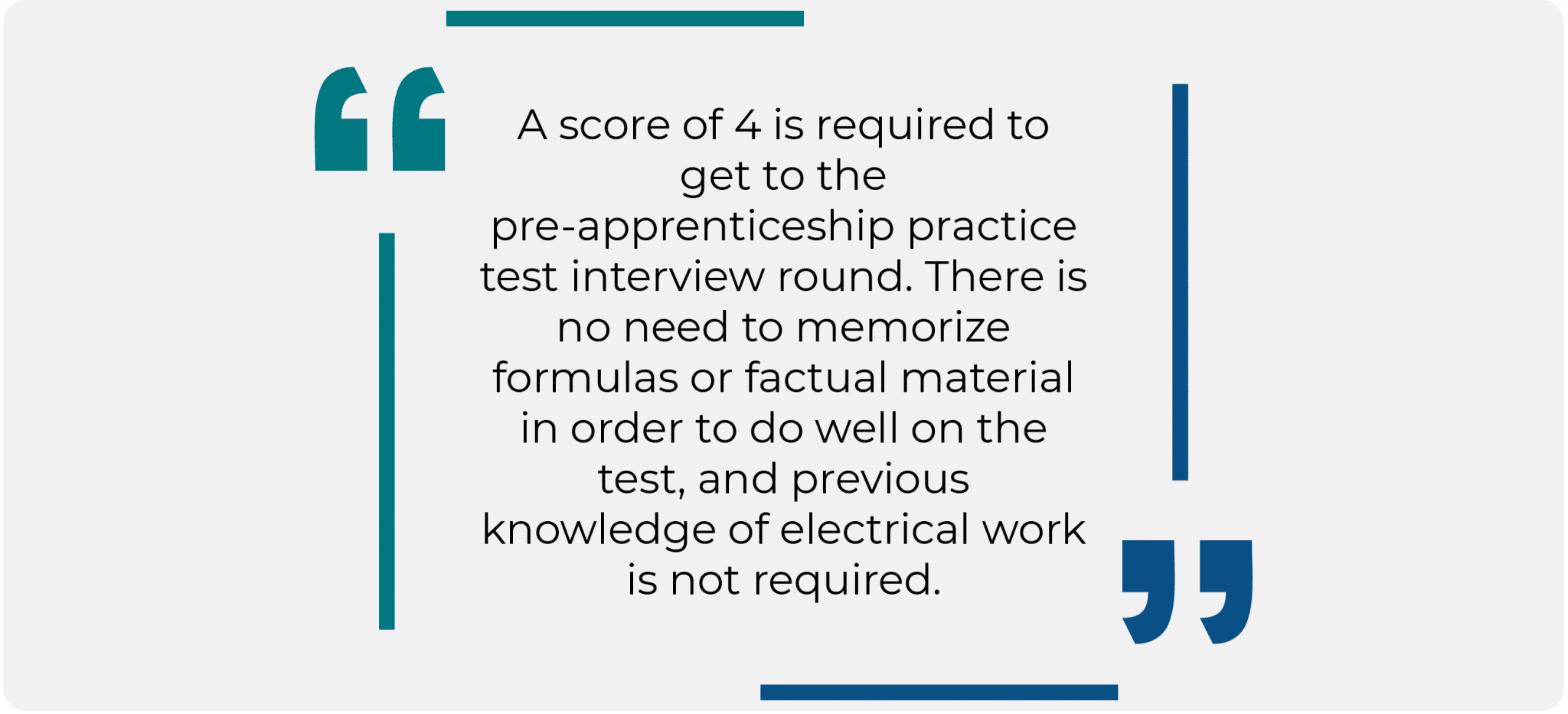
Local 26 IBEW
Based outside the nation’s capital, the 7,600+ union members help keep things running smoothly in Washington D.C. Successful aptitude test takers are invited to participate in the union’s Inside Wireman electrical 5-year apprenticeship program. The apprenticeship is run by the Joint Apprenticeship and Training Committee (JATC).
Local 77 IBEW
Located in the Pacific Northwest, Local 77 IBEW has nearly 7,000 members working in the Seattle area. After passing the aptitude test, you’ll be eligible for the union’s apprenticeship program. The five-year program run by the JATC of the Northwest Line Construction Industry will put you on track for a rewarding career as an electrician.
Local 103 IBEW
The 6,000-member strong union serving the greater Boston area are the best trained, safest electricians and telecommunication specialists. After successfully passing the aptitude test, you’ll be eligible to be invited to the Greater Boston JATC.
Local 98 IBEW
Philadelphia’s Local 98 IBEW has over 4,600 members serving the electrical needs of the City of Brotherly Love. After receiving a qualifying score on your aptitude test, candidates can apply for an Electrical Training program during the first two weeks of April, or for a Sound & Telecommunications apprenticeship on the third Thursday of each month.
Local 1 IBEW
Home of the nation’s first IBEW union, the 4,600 union members in the St. Louis region keep the lights on in the Gateway to the West. Apprenticeship training is available to you after you pass the aptitude test. It’s provided by the St. Louis Electrical Industry Training Center.
Information Sources
- IBEW – The International Brotherhood of Electrical Workers
- NECA – The National Electrical Contractors Association
- Electrical Training Alliance (formerly NJATC)
Disclaimer – All the information and prep materials on iPrep are genuine and were created for tutoring purposes. iPrep is not affiliated with IBEW nor NECA, which are the owners of the Electrical Training Alliance Aptitude Test.
NJATC Aptitude Test Sample Questions
Free IBEW NJATC practice test: Get to know what the Electrical Training Alliance Aptitude Test (aka NJATC Test) will be like by practicing with these sample questions.
Question 1 of 6
What is the next number in the following series of numbers?
7 10 15 22 31
- 39
- 41
- 42
- 40
The correct answer is 42.
Explanation:
Look at the differences between the numbers:
7 10 15 22 31
+3 +5 +7 +9
+2 +2 +2
The difference between each term is greater by two in every step. Therefore, the difference between the last displayed number of the series and the next number should be 9 + 2 = 11
Therefore, the next number of the series is 31 + 11 = 42
For learning purposes, calculate the values of the differences of the series if you had continued the series:
+3 +5 +7 +9 +11 +13 +15
Therefore, the next numbers of the series would be:
42 + 13 = 55
55 + 15 = 70
Question 2 of 6
Consider the following formula:
A = (B – 2)(C + 5)
If A = 6 and B = 0, what is the value of C?
- -0.5
- 4
- 0.5
- -8
The correct answer is -8.
Here’s a detailed video walk-through of the explanation:
In order to solve this problem correctly, you need to remember the order of operations (PEMDAS):
- Parentheses
- Exponents
- Multiplication/Division
- Addition/Subtraction
In order to find a solution, you need to isolate C.
First step – placing the values of A and B:
| A = (B – 2)(C + 5) | Remember A = 6; B = 0 |
| 6 = (0 – 2)(C + 5) | |
| 6 = -2(C + 5) |
Second step – removing the parentheses:
| 6 = -2(C + 5) | -2 is a factor of both C and 5 |
| 6 = -2*C – 2*5 | |
| 6 = -2C – 10 |
Third step – isolating C and finding the solution:
| 6 = -2C – 10 | Add 10 to both sides |
| 6 + 10 = -2C | Simplify the right side |
| 16 = -2C | |
| -8 = C |
Question 3 of 6
Factor the polynomial
x² – 3x – 18
- (x + 3)(x − 6)
- (x + 9)(x − 2)
- (x + 6)(x − 3)
- (x + 2)(x −9)
The correct answer is (x + 3)(x − 6).
Here’s a detailed video walk-through of the explanation:
Every quadratic formula is following the same construct Ax2 + Bx + C, when the coefficients A, B, and C are real numbers.
How to recognize the correct answer by looking at the answers?
Each of the answers is a product of two binomials. If in both cases the coefficient of x is 1 (as in this case), then the correct answer would consist of numbers that follow two conditions:
- The sum of the numbers is equal to the coefficient B
- The product of the numbers is equal to the coefficient C
Look at all four answers. Only the correct answer satisfies both of these conditions:
(x – 6)(x + 3) →
Sum = -6 + 3 = -3
Product = -6 * 3 = -18
The polynomial is x2 − 3x − 18.
Remember –
As another alternative solution path, you can always use the FOIL method and multiply each of the factors suggested in the answers. One of them ought to yield the correct polynomial.
Question 4 of 6
Consider the following formula:
3D = E – 3
Which of the following statements is true for this formula?
- If D is less than -1, E is positive.
- If D is greater than -3, E is negative.
- If D is greater than -1, E is positive.
- If D is greater than -3, E is positive.
The correct answer is C.
Here’s a detailed video walk-through of the explanation:
All the answers refer to the value of E as a function of the value of D. To solve the problem systematically, you can plot the graph line and compare it with statements A-D. Being that 3D = E – 3 is a linear expression, then to plot the graph line, you only need two points on the graph. The simplest points to find are the interception points with the axes. To find these, you should place in the expression D = 0 and E = 0.
If D = 0, then:
3D = E – 3
3*0 = E – 3
0 = E – 3
E = 3
And we get the first (D,E) point’s coordinates (0,3).
If E = 0, then:
3D = E – 3
3D = 0 – 3
3D = -3
D = -1
And we get the second (D,E) point’s coordinates (-1,0).
The following image depicts the plot line of this linear expression, based on these points:

If you compare statements A-D to the graph, you could see that only statement A completely false, statements B and D are partially true, and only statement C is always true.
Question 5 of 6
Evaluate the expression:
For x = 11,
x2 – 15x + 56 = ?
- 12
- 11
- -56
- 15
The correct answer is A. (12).
Here’s a detailed video walk-through of the explanation:
| x2 – 15x + 56 = | Substitute value of ‘x’ in the equation |
| 112 – 15*11 + 56 = | According to PEMDAS, solve exponents first PEMDAS |
| = 121 – 165 + 56 | The order of addition and subtraction can be changed if and only if each number maintains its arithmetic sign |
| = 121 + 56 – 165 | Add terms |
| = 177 – 165 | Subtract terms |
| = 12 |
Question 6 of 6
Evaluate the value of the unknown variable:
Y = 27
Z = Y/9
X = Y x Z
X =__?__
- 81
- 61
- 91
- 71
The correct answer is A. (81).
Here’s a detailed video walk-through of the explanation:
| Z = Y/9 | Find the value of “Z” by putting the value of “Y” in this equation, from the question |
| Z = 27/9 | Solve the fraction by dividing the numerator by the denominator |
| Z = 3 | |
| X = Y x Z | Now take the main equation involving all three variables and substitute the value of ‘Y’ from the question and ‘Z’ from above |
| X = 27 x 3 | Multiply both the terms |
| X = 81 |
Well done!
You have completed the IBEW NJATC Sample Questions section.
The complete iPrep IBEW course includes full test simulations with detailed explanations and study guides.

Free IBEW test PDF
About the course
Includes 41 practice tests (8 full-length simulations)
iPREP is a trusted test‑prep provider offering a full Electrical IBEW NJATC Aptitude Test Battery prep course, and on this page you can access free sample questions with full explanations and video walkthroughs.
You’ll get:
- Free real‑style Electrical IBEW questions
- Instant right/wrong feedback
- Step‑by‑step written solutions
- Short video explanations for every answer
Welcome to iPrep’s Electrical Training Alliance (formerly NJATC) pre-apprenticeship aptitude test course.
This course will help you boost your skills and with it your confidence toward your upcoming IBEW aptitude test. This is the test that you need to pass in order to be accepted to the IBEW or the NECA apprenticeship program. The course will provide you with the following tools and benefits:
- You will become familiar with the test’s various types of questions.
- You will be given five full-length NJATC-style simulation tests and three additional algebra and functions simulation tests. Each simulation is divided into two sections – the Algebra and Functions section and the Reading Comprehension section. Each section includes similar questions to those you will encounter in the real test with the same level of difficulty. They also have the same time limit as the real test. Experiencing the test’s time pressure will ensure it will not come as a surprise on test day.
- You will be provided with a great variety of helpful tips and video solutions for the different types of questions. Some of the tips are in the introductory sections while most are in the detailed explanations that follow each question.
- Navigating local variations in the IBEW test – Our IBEW course is designed to encompass variations across different locals. We use a comprehensive approach that ensures adaptability to a range of test scenarios, providing a solid foundation for any local variation you might encounter.
54
Learning hours
41
Practice tests
803
Questions
850
VIDEOS
By the end of this course, you will be more knowledgeable and comfortable with the aptitude test – Knowledge and familiarity with the test are the two most significant factors that can help you maximize your score and improve your chances of success.
The course is comprised of both practice and learning sessions. We will guide you through learning lessons with essential information about your upcoming electrical apprenticeship aptitude test. These lessons will help you understand the underlying techniques that are essential for succeeding on the test.
The course is then concluded by its core component – simulating full-length tests that accurately follow the structure and concepts of the Electrical Training Alliance aptitude test. Once done, you will get detailed solutions, video solutions for most algebra questions, and even see how well you performed in comparison with other people who have taken the test.
Wishing you an enjoyable learning experience!
Skills you will learn
Basic math
Basic algebra & functions
Reading comprehension
Curriculum
- Course Introduction
- Question Types Introduction
- Basic Mathematical Operations
- Fractions and Decimals
- Algebra
- Functions
- Number Series / Sequences
- Reading Comprehension
- Test-Taking Tips
- Full-Length Electrical Training Alliance-Style Aptitude Test Simulations
- Course Conclusion
Customer Testimonial

This was an excellent learning module for me. I just took my test after only using this for a couple of days and I am confident I did at least 80%. I, wish I had found it sooner, there should be a link on every PSEJATC and NJATC, and union website…it is awesome, and prepares you well.
Jesse Mann
February 26, 2019 at 10:01 PM
Reviews

Charlie K**
December 18, 2025 at 5:30 PM
Great refresher on high school algebra! If you've been out of school for some time, you should definitely get this course.

Sebastian P*******
December 18, 2025 at 2:25 AM
This course has helped me tremendously and is giving me the correct tools to prepare me for the JATC aptitude test.

Demontray B******
December 17, 2025 at 11:23 PM
Iprep is great, I chose to use another site to practice for my aptitude test and instantly regretted it. After using Iprep I am more confident that I will pass my test now thanks to Iprep

Jensen S****
December 17, 2025 at 8:09 PM
This is an amazing website to practice for the IBEW test and even to have a refresher on basic algebra. The videos were very helpful and engaging.

Aaron V****
December 17, 2025 at 6:51 PM
Overall, this course was well done and helped me tremendously. I like the amount of material and there were plenty of practice tests available through the course. I would definitely recommend it!

Dan G*******
December 17, 2025 at 6:01 PM
this has been great so far! excited to get started and see how much this really helps with the testing!

Eduardo A****
December 17, 2025 at 5:59 PM
really excited to start my course and to feel prepared for my upcoming exam this course should give me everything I need to feel ready

Cristian O***
December 17, 2025 at 8:43 AM
This course is just what I needed. I have been out of school for over twenty years and this iPrep course helped me get prepared for the aptitude test! Thank you so much!

Jeremy H****
December 17, 2025 at 2:13 AM
Took the IBEW course and was able to get an "average" and "above average" on both my math and my reading. This course is awesome

Aaron O****
December 16, 2025 at 9:43 PM
I find the iPrep course useful, helpful, and concise. I am glad I found this course online, for an excellent and reasonable price
